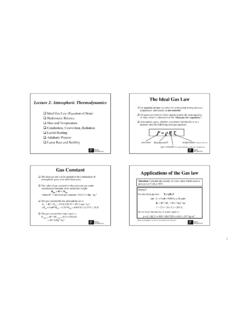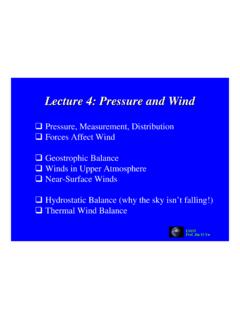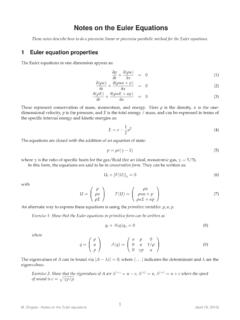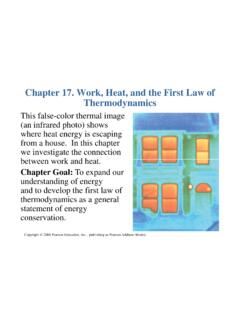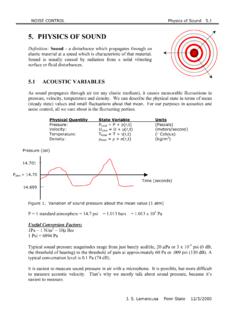Transcription of REFPROP Documentation - NIST
1 REFPROP DocumentationRelease W. Lemmon, Ian H. Bell, Marcia L. Huber, Mark O. McLindenJun 04, 2018 CONTENTS1 REFPROP Graphical User Information .. Commands ..262 REFPROP DLL API .. API ..55iiiREFPROP Documentation , Release is an acronym for REFerence fluid PROP erties. This program, developed by the National Institute ofStandards and Technology (NIST), calculates the thermodynamic and transport properties of industrially importantfluids and their mixtures. These properties can be displayed inTablesandPlotsthrough the graphical user interface;they are also accessible through spreadsheets or user-written applications accessing theREFPROP is based on the most accurate pure fluid and mixture models currently available. It implements threemodels for the thermodynamic properties of pure fluids: equations of state explicit in Helmholtz energy, the modifiedBenedict-Webb-Rubin equation of state , and an extended corresponding states (ECS) model.
2 Mixture calculationsemploy a model that applies mixing rules to the Helmholtz energy of the mixture components; it uses a departurefunction to account for the departure from ideal mixing. Viscosity and thermal conductivity are modeled with eitherfluid-specific correlations, an ECS method, or in some cases the friction theory Documentation , Release GRAPHICAL USER General About REFPROPREFPROP is an acronym for REFerence fluid PROP erties. This program, developed by the National Institute ofStandards and Technology (NIST), calculates the thermodynamic and transport properties of industrially importantfluids and their mixtures. These properties can be displayed inTablesandPlotsthrough the graphical user interface;they are also accessible through spreadsheets or user-written applications accessing theREFPROP is based on the most accurate pure fluid and mixture models currently available. It implements threemodels for the thermodynamic properties of pure fluids: equations of state explicit in Helmholtz energy, the modifiedBenedict-Webb-Rubin equation of state , and an extended corresponding states (ECS) model.
3 Mixture calculationsemploy a model that applies mixing rules to the Helmholtz energy of the mixture components; it uses a departurefunction to account for the departure from ideal mixing. Viscosity and thermal conductivity are modeled with eitherfluid-specific correlations, an ECS method, or in some cases the friction theory property formulations and fluid data files were programmed by:Eric W. Lemmon, Ian H. Bell, Marcia L. Huber, and Mark O. McLindenApplied Chemicals and Materials DivisionNational Institute of Standards and TechnologyBoulder, CO is the culmination of several years of revisions and updates. Work never stops on the developmentof thermophysical properties and equations , but the last two years have been especially intense and fully dedicatedto this release. Although there are only four authors of this work, we are very grateful to the many contributions ofour NIST colleagues, including Gary Hardin, Allan Harvey, Chris Muzny, Vladimir Diky, Ala Bazyleva, and JanielReed who have provided support over the last several versions of REFPROP .
4 Also of NIST are Adam Morey, CindyMcKneely, and Sherena Johnson who distribute the product for us to industry. A number of individuals from industryhave contributed continuously over the last several years; we are indebted to them for their help, and we thank TobiasLoew, Nik Felbab, Nicolas James, Dan Williams, Jim Pollard, and Stuart acknowledge our many colleagues whose property models we have taken from the literature, and without whichthis database would be much reduced in scope. In particular, the Ruhr University in Bochum, Germany, has for3 REFPROP Documentation , Release decades worked alongside us in the development of equations of state . The contributions of Wolfgang Wagner,Roland Span, and Monika Thol can easily be seen by browsing through the fluid information. We thank Marc Assaelof Aristotle University of Thessaloniki (Greece) for his many contributions to the development of transport propertyformulations, and Ryo Akasaka of Kyushu Sangyo University for his contributions to the refrigerant equations ofstate.
5 We also thank our colleagues within our division whose efforts have made possible the NIST/TRC SOURCEand TDE Databases, of which we have made extensive use for our data needs required to develop thermophysicalproperty REFPROP is a program built on equations of state , its entire existence is built on a foundation of experi-mental data, some of which dates back to the late 1800s. Through experimental measurements, especially the highlyaccurate values of Wolfgang Wagner, Reiner Kleinrahm, Martin Trusler, Mark McLinden, Markus Richter, their stu-dents and colleagues, and many others, equations are built that are then used throughout industry world-wide. Manythings that touch our lives have been influenced in one way or another by these measurements. Power generation aloneaffects all, and the properties from these equations influence the efficiency and design of that infrastructure. Likewise,heating, cooling, and transportation have all been influenced by the measurements and subsequent property are greatly indebted to the enormous work of so many scientists and engineers that continues unseen by development of this software package was supported by the NIST Applied Chemicals and Materials Division andthe NIST Standard Reference Data Program.
6 The development of the models and the measurement of the data onwhich REFPROP is based have been supported over a period of many years by numerous :Please visit the REFPROP FAQ web site as your first resource when you encounter difficulties orhave questions. Most email enquiries are answered by pointing to the FAQ. Using the FAQ will save valuable NIST resources that can be used to further develop REFPROP .*Certain trade names and other commercial designations are used in this work for the purpose of clarity. In no casedoes such identification imply endorsement by the National Institute of Standards and Technology, nor does it implythat the products or services so identified are necessarily the best available for the CautionsUsers of the REFPROP program should be aware of several potential pitfalls:If you experience large differences in your expected values of enthalpy or entropy as compared to those calculated bythe program, see information onReference the units in the Options/Units menu does not change the units on the tables already created, but only for newtables and equation parameters for mixtures composed of natural gas fluids come from the 2008 GERG model (seePref-erencesfor the reference).
7 The default pure fluid equations of state in REFPROP are not the same as those used inthe GERG model, rather they are more complex with lower uncertainties. The GERG equations for the pure fluidsare shorter, less complex, and faster, but slightly less accurate. To use the GERG model, as published, choose thecorresponding option under Options/Preferences. The preference screen also has an option to use the AGA8 modelfor natural gas NIST REFPROP program is designed to provide the most accurate thermophysical properties currently availablefor pure fluids and their mixtures. The present version is limited to vapor-liquid equilibrium (VLE) only and doesnot address liquid-liquid equilibrium (LLE), vapor-liquid-liquid equilibrium (VLLE) or other complex forms of phaseequilibrium. The program does not know the location of the freezing line for mixtures. Certain mixtures can potentiallyenter into these areas without giving warnings to the mixtures have components with a wide range of volatilities ( , large differences in boiling points), as indicatedby a critical temperature ratio greater than 2.
8 Certain calculations, especially saturation calculations, may fail withoutgenerating warnings. Plotting the calculation results may reveal such cases looking for discontinuities in density is agood check. Such mixtures, including many with hydrogen, helium, or water, may not have Type I critical behavior,that is they do not have a continuous critical line from one pure component to the other. The estimated criticalparameters specified in the Substance/Fluid Information screen for these types of mixtures will not be 1. REFPROP Graphical User InterfaceREFPROP Documentation , Release are cases where an input state point can result in two separate valid states . The most common is temperature-enthalpy inputs. Viewing a T-H diagram will help show how there can be two valid state points for a given example, nitrogen at 140 K and 1000 J/mol can exist at MPa and at MPa. When this situation occurs, REFPROP returns the state with the higher density.
9 See theSpecified State Pointssection for information on calculatingthe upper and lower are certain properties pertaining only to the saturation line, such as dp/dT. For most cases, displayed propertiesat saturation states are those for the single phase on the saturation boundary. Thus, derivative properties at saturationas well as saturation properties that are given along constant property paths, such as Cv, Cp, or Csat, pertain to theirstate in the single phase. Those properties label with a [sat] indicate a path along the saturation pure fluids, when the Show 2-phase option in the plot menu is selected, the generated lines for pressure andtemperature represent metastable fluid states and the calculated lines between them. These are calculations from theequation of state disregarding any saturation states and generally have no physical equations of state are available for hydrogen to account for the different quantum spin states of the hydrogen should be used in applications where it was created and stored at 250 K or above, or when it wascooled to below 250 K and stored without a catalyst for less than a day.
10 The parahydrogen equation should be usedwhere hydrogen was catalyzed or stored for several days at the normal boiling point (NBP) and used at any temperaturewithin 1 day of storage at the NBP. Since the rate of conversion between quantum states is dependent on temperature,pressure, and the storage container, these values are only estimates. For more information, see the Leachman et reference in the Fluid Information window for Copyright and DisclaimerREFPROP is a product of theNational Institute of Standards and Technology (NIST).Developed and maintained by:Applied Chemicals and Materials DivisionBoulder, CO 80305, USAD istributed byStandard Reference DataGaithersburg, MD 20899, USAC opyrightStandard Reference Databases are copyrighted by the Secretary of Commerce on behalf of the United states ofAmerica. All rights reserved. No part of the database may be reproduced, stored in a retrieval system or transmitted,in any form or by any means, electronic, mechanical, photocopying, recording or otherwise without prior National Institute of Standards and Technology (NIST) uses its best efforts to deliver a high-quality copy of thedatabase and to verify that the data contained therein have been selected on the basis of sound scientific , NIST makes no warranties to that effect, and NIST shall not be liable for any damage that may result fromerrors or omissions in the General Information5 REFPROP Documentation , Release REFPROP FAQThe REFPROP FAQ web site (located at ) provides detailed information onmany aspects of using REFPROP .
